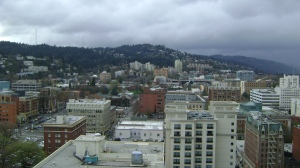 Unfortunately, I’ve only been able to attend just this one full day of the ASEH annual meeting in Portland, Oregon, but it has been pretty good. This morning I attended a panel titled “Natural and Unnatural: Bodies, Health, and Space in the 20th Century.”
Unfortunately, I’ve only been able to attend just this one full day of the ASEH annual meeting in Portland, Oregon, but it has been pretty good. This morning I attended a panel titled “Natural and Unnatural: Bodies, Health, and Space in the 20th Century.”
Broadly speaking, both the panelists’ (Samantha Scott & Bob H. Reinhardt) research addressed studies of the human body as an environment, integrating literature from public health history into environmental history. I was especially interested to hear Samantha Scott’s paper on public health reform and contagious disease in Seattle because she discussed Progressive-era reforms to the city’s milk supply and concerns over the spread of bovine tuberculosis. Her work very clearly examines the place of non-human animals in municipal public health reform, a topic I am studying in the Canadian context.
Following this session, I participated in an excellent round-table discussion on new directions in urban environmental history. If you’d like to hear our preview discussion on this topic, you can download the latest episode of the Nature’s Past podcast. I was very pleased to be on this panel with Karl Appuhn, Monica Perales, and Michael Rawson. Each panelist brought something new and interesting to the conversation and helped drive the discussion to some of the bigger questions and concerns facing scholarly researchers in urban environmental history.
One of the most interesting parts of the discussion came toward the end of the session when we got into a debate about the character of urban environmental history as a “big tent” and what defines urban environmental history. The point I tried to make was that environmental history itself shouldn’t be seen as a distinct set of topics categorized as “environmental”. Instead, it should be regarding as a methodology or a heurisitc lens (as Karl Appuhn put it this morning) for understanding the past. By examining cities, using an environmental history methodology, we can begin to see the history of cities not as artificial constructs of human design but as biological habitat for humans and non-human animals and other organisms.
 Since I wasn’t registered for any field trips, I was able to pop over to the famed Powell’s Books to do some browsing in what I can only describe as the Honest Ed’s of bookstores (a reference for Torontonian readers). I didn’t end up getting any books, but I did bump into a lot of people from the ASEH meeting. Powell’s almost seemed more like an annex to the main conference centre.
Since I wasn’t registered for any field trips, I was able to pop over to the famed Powell’s Books to do some browsing in what I can only describe as the Honest Ed’s of bookstores (a reference for Torontonian readers). I didn’t end up getting any books, but I did bump into a lot of people from the ASEH meeting. Powell’s almost seemed more like an annex to the main conference centre.
I’m hoping to catch another panel session tomorrow morning before I have to leave Portland and return to British Columbia.



